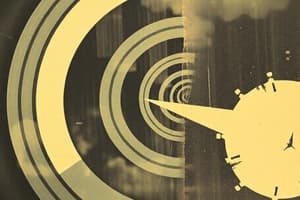Podcast
Questions and Answers
What is the change in the frequency of a sound wave as a result of motion between the sound source and the receiver?
What is the change in the frequency of a sound wave as a result of motion between the sound source and the receiver?
- Interference
- Diffraction
- Doppler effect (correct)
- Piezoelectric effect
What is the typical range of Doppler shifts that are in the audible range?
What is the typical range of Doppler shifts that are in the audible range?
- 20 kHz to 2 MHz
- 2 MHz to 10 MHz
- 20 Hz to 20 kHz (correct)
- 2 MHz to 200 MHz
Which Doppler technique does not provide range resolution?
Which Doppler technique does not provide range resolution?
- Power Doppler
- Pulsed Wave Doppler
- Color Doppler
- Continuous Wave Doppler (correct)
What is the effect of increasing the wall filter during Doppler sampling?
What is the effect of increasing the wall filter during Doppler sampling?
How is velocity related to the Doppler shift?
How is velocity related to the Doppler shift?
Is there a Doppler shift at 90 degrees?
Is there a Doppler shift at 90 degrees?
What is the primary cause of the Doppler Effect?
What is the primary cause of the Doppler Effect?
Can sound waves exist in a vacuum?
Can sound waves exist in a vacuum?
What happens to the frequency when relative motion is toward an observer?
What happens to the frequency when relative motion is toward an observer?
If the returning frequency is lower than the transmitted frequency, what does it indicate?
If the returning frequency is lower than the transmitted frequency, what does it indicate?
If the velocity of an object doubles, how does it affect the Doppler shift frequency?
If the velocity of an object doubles, how does it affect the Doppler shift frequency?
In the Doppler equation, where is the cosine term located?
In the Doppler equation, where is the cosine term located?
Flashcards are hidden until you start studying
Study Notes
Doppler Effect
- The Doppler effect is the change in frequency of a sound wave due to motion between the sound source and the receiver.
- Doppler shifts range from 20 Hz to 20 kHz, which are in the audible range.
Velocity and Doppler Shift
- Velocity is directly proportional to the Doppler shift.
- If the velocity doubles, the Doppler shift frequency also doubles.
Doppler Equations
- There are two types of Doppler shifts: one when the sound wave from the transducer strikes the blood in motion, and another when the reflected wave returns from the blood cells.
- The cosine of the angle is directly proportional to the Doppler shift.
Doppler Techniques
- Continuous wave (CW) Doppler does not provide range resolution.
- Pulsed wave Doppler provides range resolution.
Wall Filters
- If wall filters are set too high, lower velocity signals that produce low frequency shifts are eliminated, making it impossible to appreciate low velocities.
- Increasing the wall filter during Doppler sampling reduces the display of low frequency shifts.
Aliasing
- Aliasing can be beneficial in identifying the jet, as it makes the jet stand out against the normal flow.
- To eliminate the aliasing artifact, the transmit frequency should be lowered.
Direction of Blood Flow
- In non-directional power Doppler, direction cannot be determined.
- In color Doppler, the direction of blood flow can be determined.
True or False
- There is no Doppler shift at 90 degrees.
- Sound waves cannot exist in a vacuum.
- A shorter wavelength represents a higher frequency and occurs when relative motion is toward an observer.
Studying That Suits You
Use AI to generate personalized quizzes and flashcards to suit your learning preferences.




